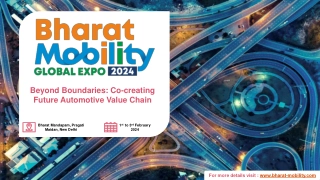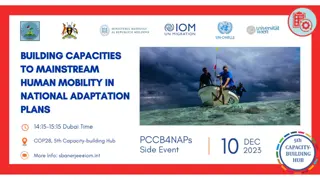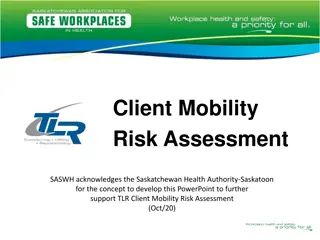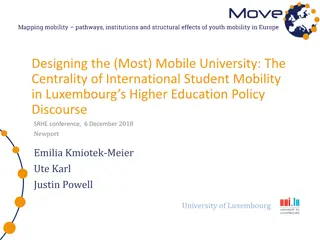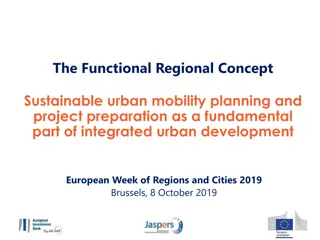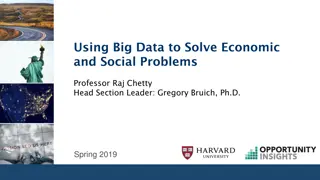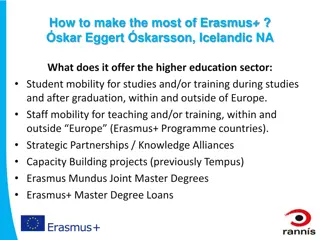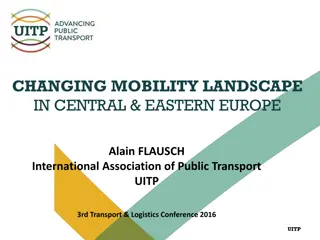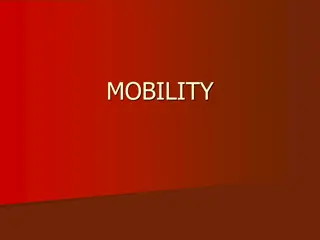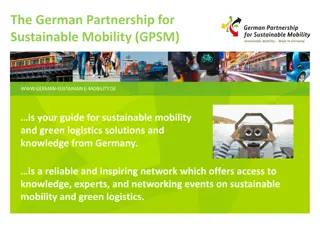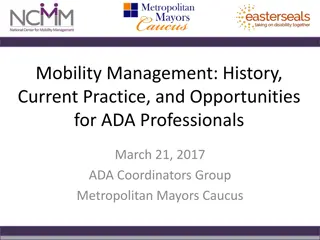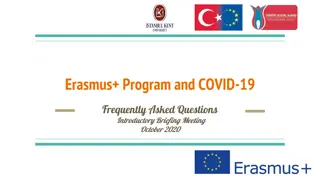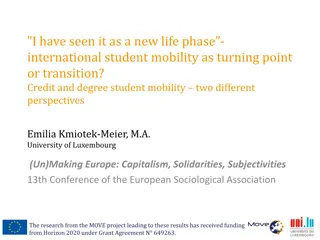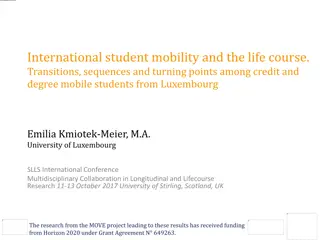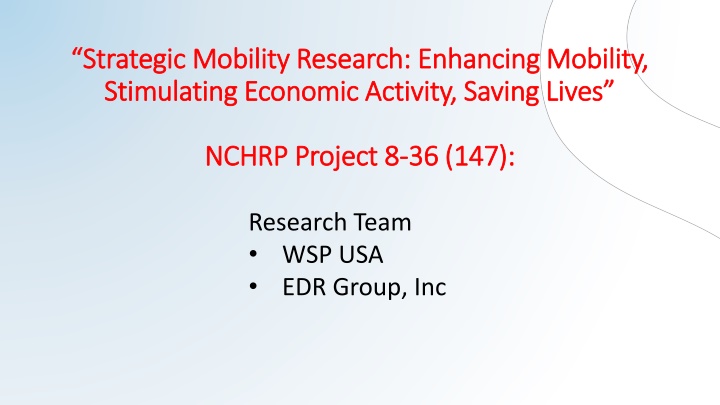
Enhancing Strategic Mobility Research Program
Develop a comprehensive plan and research agenda to further define mobility-related characteristics of the transportation system. Explore opportunities for piloting research and product development from the Strategic Mobility Research Program. Tasks include project management, stakeholder outreach, and developing a research plan through literature review and targeted interviews with transportation authorities.
Download Presentation

Please find below an Image/Link to download the presentation.
The content on the website is provided AS IS for your information and personal use only. It may not be sold, licensed, or shared on other websites without obtaining consent from the author. If you encounter any issues during the download, it is possible that the publisher has removed the file from their server.
You are allowed to download the files provided on this website for personal or commercial use, subject to the condition that they are used lawfully. All files are the property of their respective owners.
The content on the website is provided AS IS for your information and personal use only. It may not be sold, licensed, or shared on other websites without obtaining consent from the author.
E N D
Presentation Transcript
Strategic Mobility Research: Enhancing Mobility, Strategic Mobility Research: Enhancing Mobility, Stimulating Economic Activity, Saving Lives Stimulating Economic Activity, Saving Lives NCHRP Project 8 NCHRP Project 8- -36 (147): 36 (147): Research Team WSP USA EDR Group, Inc
Research Objectives Research Objectives Develop a comprehensive plan and proposed research agenda for a Strategic Mobility Research Program (SMRP) Identify and prioritize research topics that help to further define mobility-related characteristics of the transportation system Identify opportunities for piloting suggested research and product development from the SMRP
Research Approach Research Approach Task 1: Project Management and Kickoff Task 2: Mobility Issues Distilled from Past Research and Programs Task 3: Develop Stakeholder Outreach Plan Task 4: Conduct Outreach Task 5: Summarize Outreach Findings Task 6: Develop and Present Research Plan
Methodology Methodology Literature review Review of past strategic transportation research and of the programs that supported it Targeted interviews State DOTs Metropolitan planning organization (MPOs) City transportation officials Transit agency officials Transportation authorities Professional associations Mobility researchers
What is Meant by Strategic? (from NCHRP 8 What is Meant by Strategic ? (from NCHRP 8- -36 (143) 36 (143) Long-term or system-focused Decision-framing, defining new goals or values. New Zealand Transport Ministry . difficult issues, tasks, or situations that require concerted effort to be addressed successfully Issues relating to the network or connected nature of the transportation system Strategies for getting things done
Five Areas for Strategic Mobility Research (from Literature Review) Transportation Technology - Evolving nature of mobility technologies and the impacts they could have. Transportation Demand - Evolving transportation user needs and ways service providers can use new technologies. Transportation Supply - Infrastructure and services that permit the implementation of new technologies.
Five Areas for Strategic Mobility Research (from Literature Review), cont d Transportation Context Factors - How trends and societal factors could affect the way we travel and move goods (if travel is even necessary); this includes the changing socio- demographic changes likely to affect mobility use. Transportation Impacts and Benefits - How various efficiency, equity, and social effects of new mobility technologies may be captured.
In addition, Three Cross-Cutting Research Themes (from Literature Review and Interviews) System Design and Operation Institutional Collaboration and Implementation Feasibility and Desirability
For example, in the Technology Thematic Area .. Research Theme Vehicle Automation labor displacement, risk aversion, financial constraints, market size, workforce capability Transit System Design automation, mobility-on-demand, passenger experience considerations Design and Operation Vehicle Electrification charging management services, traffic management tools, range prediction, navigation Data Management urban-scale data systems to support overall transportation system design and operation improvement Cross-sector Collaboration private role in public services, local decision-making vis- -vis automation impacts, vehicle charging infrastructure availability and reliability Collaboration and Implementation Private Role Approaches fare payments, labor issues, accessibility, liability, data collection/management, procurement Intergovernmental Coordination regulatory structures, jurisdictional boundaries, enforcement Safety & Security software/hardware limitations, human factors, cybersecurity, emergency response, impacts on people with disabilities (e.g., quiet operations), road user safety Feasibility and Desirability Public Sector Roles new communication networks, internet of things (IoT)
Strategic Mobility Research Program Organized Around Three Themes New Forms of Mobility Changing Society and Mobility Institutional Strategies
Proposed Initial Research Topics and Primary Proposed Initial Research Topics and Primary Relationship to Research Focus Areas Relationship to Research Focus Areas Research Themes Changing Society and Mobility Evolving Mobility Options Creating Institutional Capability Research Topics Mid- to Small-sized Region Mobility Strategies Equity Implications of Evolving Mobility Markets: X X X Future Freight Mobility Needs and Issues Automation and Artificial Intelligence (AI) Strategies and Mobility: X X X X System Vulnerabilities X X Uncertainties and Transportation Decision Making X X
Proposed Initial Research Topics and Primary Proposed Initial Research Topics and Primary Relationship to Research Focus Areas, cont d Relationship to Research Focus Areas, cont d Research Themes Changing Society and Mobility Evolving Mobility Options Creating Institutional Capability Research Topics New Land Use Concepts/Patterns and Mobility X X Global Trade Implications for Freight Movement: Mobility and xxxxx (multiple public policy applications) Modernizing Transportation Agencies X X X X Next Generation Transit Agencies: X New Risk-based Decision-making Frameworks Analysis Capability X X X
Research Research Process Process
Suggested Steps for Successful Research Key Characteristics of Effective Ideas Generation for Research Pathways 1. Opportunities for collaborative ideas generation, and alliances in doing so 2. Broadly-available portal for introducing research ideas into the research process 3. Opportunities for DOT customers/constituencies to provide input 4. Opportunities for research ideas focusing on DOT contextual issues 5. Taking advantage of those who are thinking more strategically on future challenges and what that might mean for society, in general, and transportation, specifically
Suggested Steps for Successful Research Key Characteristics of Effective Translation Processes for Research Pathways 1. Opportunities for collaborative descriptions of strategic planning research project statements 2. Partnerships and alliances in supporting strategic planning research project statements, and leadership in so doing 3. Some elements of broader research impacts in the guidance provided to researchers on developing problem statements 4. Central portal or guidance document having centralized information on research statement submittals
Suggested Steps for Successful Research Key Characteristics of Effective Selection Processes for Research Pathways 1. Opportunities for collaborative selection of strategic planning research project statements 2. Selection criteria that promote strategic planning research projects 3. Senior executive leadership buy-in into the value and need for strategic planning research 4. Planning input and influence in the selection process 5. Assessing the impact of strategic planning research on positioning the agency for soon-to-occur challenges
Phasing of the Strategic Mobility Research Program (SMRP) Phasing of the Strategic Mobility Research Program (SMRP)
SMRP Research Roadmap SMRP Research Roadmap
Incremental Implementation Strategy for an SMRP Incremental Implementation Strategy for an SMRP Cooperative Research Program-based Funding Congress- mandated SMRP Joint/Collaborative- based Funding University Transportation Center-based Funding
Recommendations on Implementation 1.TRB--provide leadership in concert with AASHTO, AMPO, NARC, APTA, FHWA, and FTA in developing a joint collaborative research structure 2.Set-aside some CRP funding for SMRP projects 3.Incorporate SMRP topics either into next federal transportation the enabling language (possibly in the UTC language) or in the USDOT guidance implementing the program


